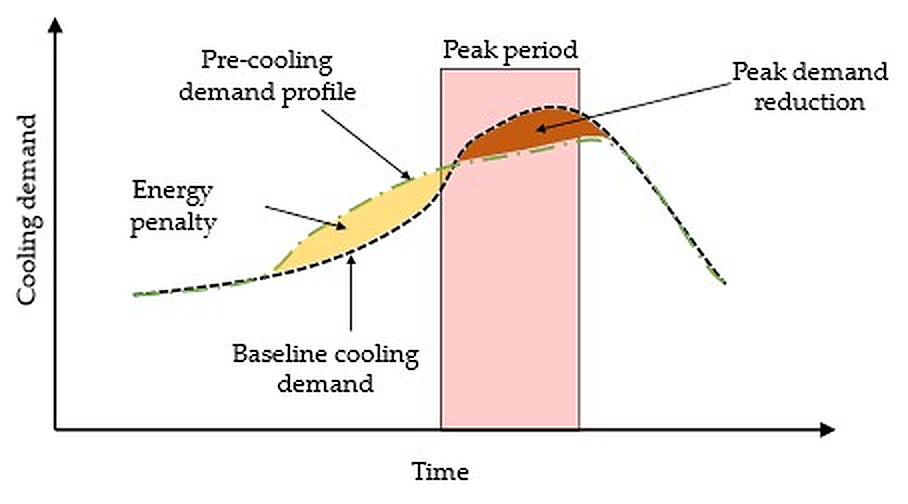Researchers in Australia have looked at how rooftop PV generation could be used to run air conditioners (AC) to pre-cool residential and commercial buildings.
The scientists defined the proposed concept as “solar pre-cooling.” It purportedly offers benefits in terms of mitigating low minimum demand in electricity networks, flattening the grid's net demand profile, and reducing electricity bills.
“Pre-cooling can be implemented in all kinds of buildings that have an AC unit. Solar pre-cooling in residential, commercial, and office buildings have been studied in the literature and proved to be practical,” researcher Gloria Pignatta told pv magazine.
The scientists considered the thermal mass of buildings as a virtual battery that could be used to shift or shave peak demand caused by AC systems.
“Pre-cooling means charging building thermal mass before peak demand onset by reducing thermal mass temperature and then discharging the coolness during the peak period,” the scientists explained. “This is typically done by reducing the thermostat setpoint a few hours before the expected peak period to force the AC to switch on.”
Pre-cooling can be performed with three thermal mass activation methods: surface activation, forced-air activation, and hydronic activation.
“Whether or not thermal mass activation results in energy cost reduction depends on the AC control strategy that defines the temperature setpoint trajectory or AC schedule,” the academics said.
The identified several factors that could help to reduce energy costs. They include reducing peak power, which is beneficial for commercial and office buildings with a demand charge component in their electricity bills, and shifting AC demand to off-peak hours with cheap electricity prices. Other factors include the reduction of mechanical cooling requirements by using night ventilation, and higher efficiency of air-conditioning units as they operates in lower ambient temperatures.
Popular content

University of New South Wales (UNSW)
The researchers said pre-cooling can be more beneficial if the surplus PV generation during the day is used to pre-cool the building instead of importing electricity from the grid. This is because the feed-in tariff (FIT) paid for rooftop PV generation is lower than the retail electricity prices, and the future tariff structures might not have a FiT component for exporting to the grid.
“By using the surplus PV generation for solar pre-cooling, households use cheap or free electricity to pre-cool the building, which consequently reduces their imports from the grid during peak hours, when tariff rates are expensive,” Pignatta said. “Moreover, reducing the export of surplus PV to the grid increases levels of self-consumption, lowering PV’s contribution to low network minimum demand and reducing the operational challenges for managing the low minimum demand.”
Although pre-cooling and solar pre-cooling can be beneficial to the network, the potential cost savings and reduction in peak AC demand are not necessarily significant for all buildings, said the researchers.
“The potential of pre-cooling and solar pre-cooling is based on a range of technical, economic, and behavioral factors such as the energy efficiency of a building, its construction materials, AC unit rated capacity, PV system rated capacity, occupants’ thermal comfort expectations and time-of-use consumption patterns are some of the factors that directly affect the pre-cooling/solar pre-cooling potential of a building,” they said. “A gap in the literature is the lack of thorough investigation in solar pre-cooling using actual monitored household data, including rooftop PV generation, appliance-level demand, and building thermal dynamics. Such studies can reveal the actual potential of solar pre-cooling with more value than simulation-based approaches.”
The researchers described their findings in “Demand response via pre-cooling and solar pre-cooling: a review,” which was recently published in Energy and Buildings.
“It is worth mentioning that the field of solar pre-cooling has the potential for further investigation in terms of cooling technology,” they concluded. “Grid-connected or stand-alone PV-integrated heat pumps, adsorption, absorption, and desiccant cooling systems driven by solar energy can supply cooling to pre-cool the building.”
The research group includes scientists from the Commonwealth Scientific and Industrial Research Organisation (CSIRO) and the University of New South Wales (UNSW) in Australia, as well as researchers from the Collaboration on Energy and Environmental Markets and the High-Performance Architecture research cluster.
This content is protected by copyright and may not be reused. If you want to cooperate with us and would like to reuse some of our content, please contact: editors@pv-magazine.com.



This example of Mass Thermal Storage for Time-Shifting which is just 1 of 3+ forms of Thermal Storage available to all buildings. The others are Phase Change such as panels or tanks, simple water tanks, and Geothermal Heat Exchangers with Geothermal Heat Pumps which give the best time-shifting opportunity even spreading out loads over 2+ seasons. The described approach is the easiest to implement and will benefit the most from real-time power pricing. GHP is the most beneficial overall but the has the highest initial cost. The others are in between and have not received enough attention to date! We are doing research in this area and hope to have a tool out soon so anyone can easily compare all the options.